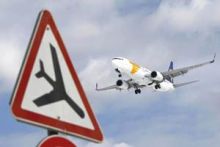Ukrainian air companies may be able in the foreseeable future to make more flights over the US, following the existing and the new routes. For this purpose, the US Federal Aviation Administration (FAA) should shift Ukraine from Category 2 to Category 1 in its safety ratings. This country was placed into the less prestigious category back in 2005, when the FAA has announced it was unsatisfied with the Ukrainian Air Code, which comprised a lot of outdated provisions, and with a still imperfect structure of the State Aviation Service.
Yet Borys Kolesnikov, Vice-Premier and Minister for the Infrastructure, recently assured the Ukrainians that an agreement to liberalize the US-Ukraine air passenger market might be signed before the end of the current year. He said this after negotiating in Washington with US Transport Department and Boeing top executives. “I think we are very close to signing an Open Sky agreement with the US before the end of this year,” the vice-premier said and added that Ukrainian companies’ airplanes would be able to fly to any US city without restrictions and American ones to any city of Ukraine.
On the one hand, one should not take Kolesnikov’s promises at face value. Firstly, he already forecast in the last year’s summer that the FAA would soon lift its restrictions. Secondly, the official has repeatedly said that Ukraine is on the point of signing an Open Sky treaty with the European Union. This was supposed to intensify competition on the air transportation market, improve the quality of service, reduce ticket prices, etc. Both promises still remain unfulfilled.
On the other hand, the vice-premier may have made the current forecasts because FAA experts are expected to submit before the end of 2012 their conclusions about the recent audit of the Ukrainian aviation authorities. Last year Ukraine approved a new version of the Air Code adopted back in 1993. The State Aviation Service has already been transformed. This really inspires a hope that Ukraine will finally win back the lost positions.
The AeroSvit air company is keenly interested in the FAA lifting its restrictions: owing to the latter, the company can make as few as 260 Kyiv-New York flights a year (5 times a week). Last spring Yevhen Treskunov, secretary of the Ukrainian Aviation Group (which AeroSvit is a part of), told the media that the expansion of routes would depend on which company AeroSvit will sign a cooperation agreement with. “Category 2 does not authorize Ukrainian companies to sign code-share agreements with American ones. Once the restrictions are lifted, our partner will be identified, and we will jointly work out an optimal route network,” he said.
Another major Ukrainian air carrier, International Airlines of Ukraine (IAU), is so far unable to take flights to the US because there are no long-haul airplanes in its fleet. According to company president Yurii Miroshnykov’s recent statements, IAU is planning to acquire two long-haul liners next year. At the same time, the company wants to straighten its considerable Westward tilt. So, in all probability, there will be flights to Beijing and Bangkok.
In the view of aviation expert, Candidate of Sciences (Economics), Artur Vinniukov-Proshchenko, Ukraine’s return to the FAA Category 1 safety rating is largely a question of prestige. “We might as well make an Open Sky deal with, say, Australia – this would fetch Ukraine the same advantages. The point is it is not a very profitable direction – not so many passengers fly there. Therefore, AeroSvit is unlikely to map out new routes in the US very soon,” he believes.
As for US air companies, none of them is so far willing to fly to Ukrainian airports (long-haul planes can land in Kyiv-Boryspil, Lviv, and Donetsk). At first glance, they may be afraid to do so for fear of going bankrupt. But the US law protects air companies from bankruptcy for a time that is long enough for a company to be reorganized. Debts are frozen, and companies can continue their operations, without running into new debts, and pay off the old ones in due time. Therefore, if necessary, US air carriers willingly seize this opportunity. The bottom line is that US air companies do not yet consider Ukraine as a promising direction.
Incidentally, in 2010 the US-based Delta Airlines discontinued New York-Kyiv flights which it had been making since 2006. In the last year’s spring tickets began to be booked again for this route, but then the company refused to resume flights.
No wonder that Ukrainian air companies have never said there will be any danger for them if an Open Sky deal is signed with the US. What they were really afraid of was an Open Sky deal with the European Union because they were aware of the interest of large European players in this market. They tried, year by year, to persuade all and, first of all, the government that there should be no haste in this because, otherwise, national companies would just fail to endure the competition. Apparently, nobody awaits this kind of competition on the part of the US.
Nevertheless, US Air Transport Association President and CEO Nicholas Calio forecast last year that the next decade would see the main rise of the tourist flow on international routes, mostly in the emerging economy countries. Ukraine is one of them, incidentally.







